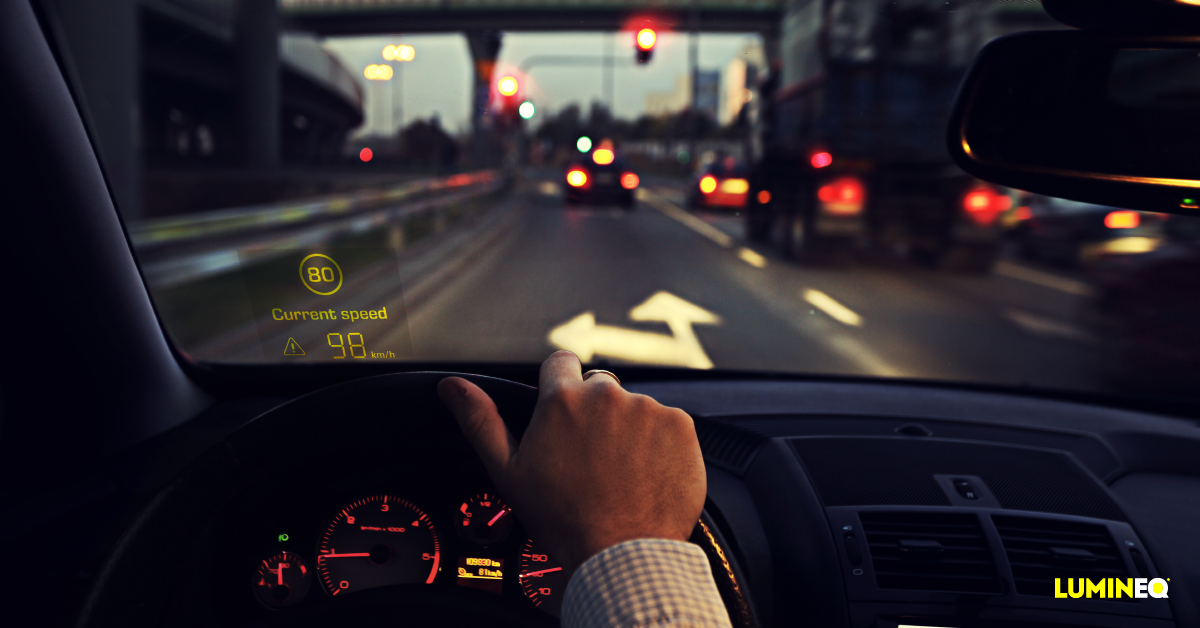HUD goggles and other wearable virtual reality devices are receiving loads of attention these days, but the topic of this blog post are HUD glasses of another kind: Transparent Lumineq displays that have been laminated in or on a windscreen for showing driver information.
Head-up displays are useful and practical and improve driver ergonomics. They can also provide important safety information. The traditional projector-based head-up solutions have, however, characteristics, which limit their use in some vehicles.
Here are five reasons why a transparent electroluminescent display inside the windshield glass can be a superior alternative for a traditional car HUD unit.
1) HUD for a vertical windshield
When the information to be displayed in the driver’s line of sight is projected from below in an angle, the image is distorted. When the angle is small, adjusting the image is still possible, but as the angle between the windscreen and the projector becomes larger, projecting a clear and rectilinear image becomes harder. If the windshield is too steep for a projected HUD, an in-glass laminated transparent display offers a better way to create a head-up display.
2) Head-up displays for safety and demanding conditions
Even if head-up displays are becoming commonplace in passenger cars, they are still relatively rare in work vehicles, race cars and other vehicles that are used in tough settings. The main reason for this is simply that projectors that tolerate impacts and vibrations are often extremely expensive. In harsh environments, a HUD solution that is based on a durable electroluminescent display offers higher performance and longer life time.
Reliability of the HUD system is critical in applications relating to safety. When the head-up display is used for safety warnings, the target is to make sure that important information will never be missed while minimizing driver distraction in normal circumstances. For vital information that needs to be displayed without fail in all situations, a robust and reliable HUD integrated in glass is the perfect solution.
3) HUD image that must be clear in all situations
The other common issue with projected HUD units in heavy use and demanding surroundings is image clarity. When the vehicle is shaking, also the projector will move relative to the windshield. A projected image will not stay clear. In these situations, a display, which is laminated in the windscreen glass will be more stationary, endures shocks better and produces a clearer image at all times.
Moreover, in-glass laminated displays offer superior crystal-clear image quality with standard window glass. Contrary to the special glass types or filters that projective HUD solutions may require, there are no extra requirements for the windscreen when Lumineq displays are used.
4) HUD solutions for limited space
Most people who are happy users of head-up displays have probably never seen the actual projector or even thought about how the image is created, but the designers and engineers who are responsible for dashboard design know all too well that a HUD projector takes quite a bit of space. When the head-up display is created with a transparent display which is laminated in the windshield, the space of the projector can be used for other devices. This also allows more freedom for dashboard design.
5) HUD display with a wide viewing angle
While projected head-up displays in cars can offer a convenient way to provide the driver additional information in the line of sight, they create an image that can only be viewed by the driver. In applications, where the information displayed in the windshield would be useful for passengers, the limited focus area of the HUD projector may prohibit the ideal placement of the HUD image.
Transparent Lumineq displays have an exceptionally large viewing angle. If the HUD information needs to be displayed to other persons in the vehicle in addition to the driver, in-glass laminated displays make a multi-display set-up possible without complicated projector equipment. It is also easy to laminate electroluminescent displays in side windows for passenger information.
Read more about our in-glass laminated Lumineq displays.
